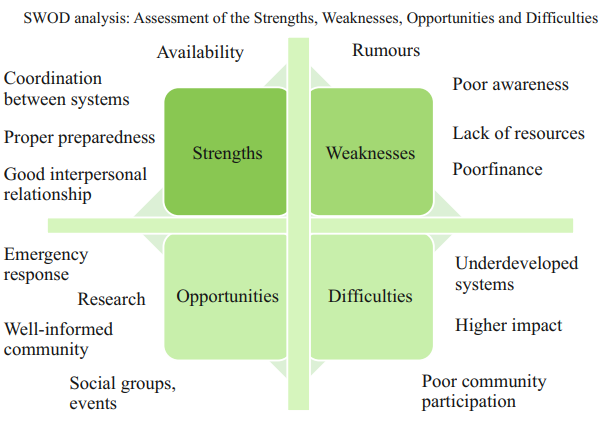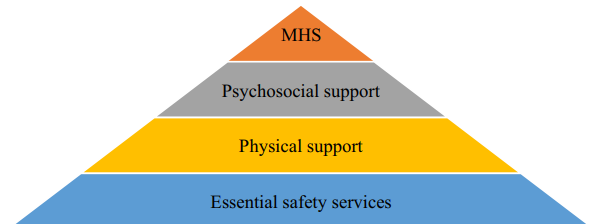Psychosocial needs Assessment
Psychosocial needs Assessment
Psychosocial needs are the psychological and social requirements that communities, families or individuals have just after the disasters. Knowledge on the psychosocial needs of the individuals, families or communities help in planning better intervention strategies. Any psychosocial assessment should provide information regarding the following:
| Individual Assessment | Family Assessment | Community Assessment |
|
|
|
Rapid need assessment in first two weeks after the disaster would reduce recall bias (not remembering the accurate information). The need assessment should also maintain conformity with the socio-cultural context of the community (traditions, beliefs, values, practices, norms and local perceptions and cultural/religious coping).
Psychosocial Needs Assessment Techniques, ICRC & IFRC, 2008

Community Assessment Tools
- Routine change mapping: It shows how the community members used to spend their whole day and how it has changed after the disaster.
- Disaster timeline: Achronological account of disaster events that has happened in the past and how people reacted to it.
- Resource claim: It is a method used to quantify or know the number of people receiving a particular service or belonging to a particular group.
- Calendar of seasons: This is used especially in rural environments to know about the local seasons, climate, patterns of rainfall, livestock management, agriculture/livestock production, sales, workforce involved and common problems experienced (drought, famine, over production, etc.). It can also talk about the seasonal outbreaks, health condition, and hazards.
- Ranking of issues: This method helps in understanding the local preferences and order of ranking by the community.
- Stakeholder exploration: Identifying individuals, groups, local authorities affected by the disaster, their interests, power relations, roles, existing strengths and resources.
- Root cause identification: It is a debate that is organised in the community to unveil the core causes for a specific problem and explains cause/effect relationship.
- Understanding community organisations: It helps in understanding the nature and type of support provided or available in an organisation.
Other considerations
 The need assessment should bridge between the needs and the services. Almost all the people affected by disaster would require basic facilities and services that ensure safety and security. If there are 100 people in the community, 95 persons will have different reactions to the event; around 50 to 70 people would suffer from mild, moderate to severe psychological distress. The distress created after any disasters can be minimised by strategies aiming at promotion of family or community support. Of the 100 affected people, 15 to 30 people might develop mild to moderate mental disorder. It is essential to focus on those people using appropriate psychosocial support services to prevent further worsening. Only 3 to 4 might suffer severe mental disorder and such individuals need to be identified earlier and have to be referred for mental health treatment. Along with the details discussed above, the needs assessment should also help in providing answers to the following questions: NGOs working in the community, availability of trained manpower for PSSMHS, assessment of additional manpower required for future work, who would require PSFA, PSS and MHS and vulnerable groups in the community.
The need assessment should bridge between the needs and the services. Almost all the people affected by disaster would require basic facilities and services that ensure safety and security. If there are 100 people in the community, 95 persons will have different reactions to the event; around 50 to 70 people would suffer from mild, moderate to severe psychological distress. The distress created after any disasters can be minimised by strategies aiming at promotion of family or community support. Of the 100 affected people, 15 to 30 people might develop mild to moderate mental disorder. It is essential to focus on those people using appropriate psychosocial support services to prevent further worsening. Only 3 to 4 might suffer severe mental disorder and such individuals need to be identified earlier and have to be referred for mental health treatment. Along with the details discussed above, the needs assessment should also help in providing answers to the following questions: NGOs working in the community, availability of trained manpower for PSSMHS, assessment of additional manpower required for future work, who would require PSFA, PSS and MHS and vulnerable groups in the community.
Assessment of needs should involve all the stakeholders in the community like local leaders, community groups, government (health, education, WCD, youth development, SJD, revenue) and nongovernment organisations, faith-based institutions, etc. Methods like observation, field surveys, individual interviews, group discussions would help in assessing the psychosocial needs of the disaster-affected communities. Diverse populations including all the genders, age groups, cultural, linguistic, religious groups need to be included. Care should be taken that assessment fatigue (same community being assessed repeatedly by different stakeholders) does not happen. Structured and scientific need assessment helps in developing accurate intervention measures and enhances the quality of the intervention.
Last Modified : 11/23/2023
This topic covers the information about National D...
Provides summary of District Disaster Management P...
This topic provides information about Emergency He...
This topic provides information about Internationa...
